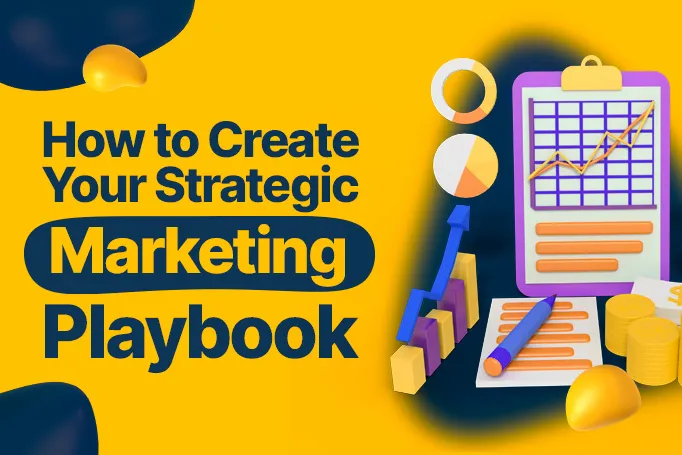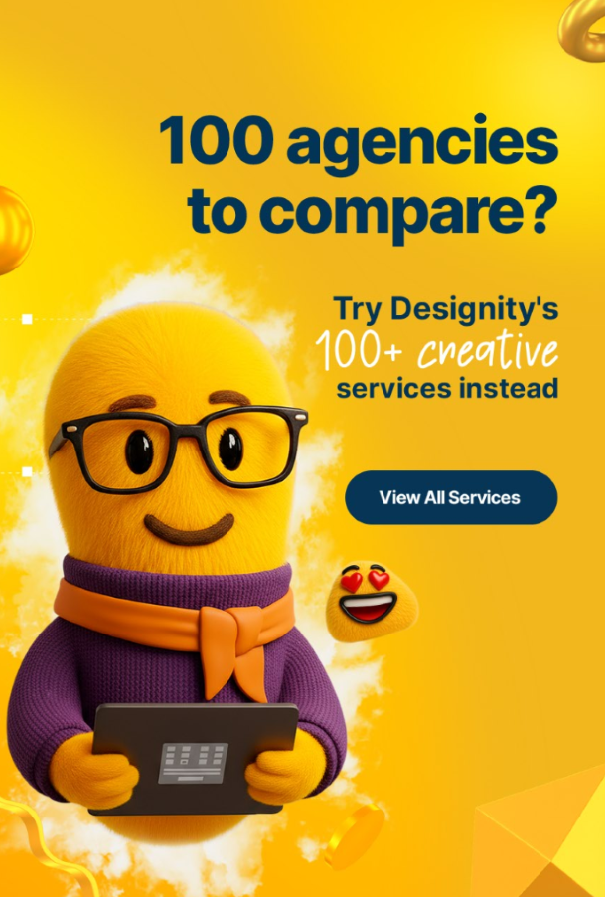Navigating the complex world of marketing can really take it out of you!
And in today’s competitive landscape, if your brand wants to succeed, you’re going to need more than just a rough outline of where your marketing strategies are going. You’re going to need a detailed and strategic marketing playbook.
That’s the hard part, though, so if you need a little guidance to get you there, then that’s okay!
Because we’ve got you covered.
Today’s blog is going to take you through the strategic marketing process to help empower you to transform your marketing approach and start seeing the success you deserve!
Let’s get started!
What is Strategic Marketing?

Strategic marketing is an approach to marketing your goods or services in a way that’s more … strategic.
It’s a thoughtful and planned-out approach that involves developing a comprehensive plan that aligns your marketing activities with your overall business goals.
You’ll have to consider factors like your target customers, your market position, your competitor’s positions, and your brand’s long-term objectives and then use that data to make deliberate choices to help your company win a competitive advantage and achieve long-term and sustainable success.
How is it Different from Regular Marketing?
So … marketing, right?
Not quite.
While “marketing” is a very broad term meaning the overall process of the way your brand promotes and sells your products or services, strategic marketing is a more intentional and goal-oriented subset.
The strategic marketing process is made up of 4 phases (more on that in a bit!) and while each of those phases has its own goals and requirements, it’s all a very circular process.
What Can Implementing a Strategic Marketing Plan Do for My Brand?
Quite a bit, actually!
A strategic marketing plan offers several benefits to your brand, helping you achieve your goals and gain a competitive edge in the market.
Here are some key advantages:
- Clear Direction — Strategic marketing provides a clear direction for the business by aligning marketing efforts with overall business objectives. It ensures that your marketing activities contribute directly to your company's mission and vision.
- Competitive Advantage — By conducting thorough market research and analysis, strategic marketing helps identify your brand's unique selling propositions (USPs) and positions it effectively against your competitors. This can lead to a sustainable competitive advantage.
- Targeted Approach — Strategic marketing focuses on understanding your target audience and tailoring your marketing efforts to meet their specific needs, paint points, and preferences. This targeted approach increases the effectiveness of your marketing campaigns.
- Resource Optimization — It helps you allocate resources more efficiently by prioritizing those marketing channels that are consistently giving you the best results. This keeps you from wasting resources on strategies that may not align with your business's objectives.
- Brand Building — Strategic marketing plays a crucial role in building up your brand image. It keeps your messaging and branding consistent across all channels, to encourage a strong and positive perception among your customers.
- Adaptability — A strategic marketing plan allows businesses to adapt to changes in the market environment, customer behavior, and industry trends. It provides a framework for responding to challenges and opportunities in a dynamic business landscape.
- Measurable Results — Strategic marketing involves setting specific, measurable, achievable, relevant, and time-bound (SMART) goals. This allows you to track and measure the success of your marketing efforts and make data-driven decisions.
- Customer Loyalty — By understanding customer needs and preferences, strategic marketing helps build lasting relationships with your customers. This can lead to increased customer loyalty and repeat business.
- Innovation — Strategic marketing encourages businesses to stay innovative and explore new opportunities for growth. It involves staying informed about industry trends and emerging technologies, fostering a culture of innovation.
- Long-Term Success — Ultimately, strategic marketing contributes to the long-term success and sustainability of a business. It provides a roadmap for achieving goals, adapting to changes, and staying relevant in the market over time.
How to Create Your Own Strategic Marketing Playbook

Curious about how you can get started with creating your own strategic marketing playbook?
We’re glad you asked!
Here are the steps you’ll need to take to plan out your strategies!
Phase 1: Set Your Goals
In the first phase of your marketing playbook, you’ll need to decide what it is that your brand is working towards.
Sit down with your team and decide what you want to achieve. Whether it’s enhanced brand awareness, a boost in sales, expanded market presence or to create buzz for a new product or service, be sure that you set clear, definable, and measurable goals.
Using SMART Goals here is very helpful to keep you on the right track. If you aren’t familiar with that, here’s a quick rundown:
- Specific — Clearly define what you want to achieve. Be precise and detailed about your goal to eliminate any confusion.
- Measurable — Establish criteria for tracking your progress and determine how you'll quantify your goal's success. This allows more objective and concrete assessment.
- Achievable — Make sure that your goal is realistic and feasible. It should challenge you but still be attainable with some effort and commitment.
- Relevant — Your goal should align with broader objectives and be significant to your overall mission.
- Time-Bound — Set a specific timeframe or deadline for achieving the goal. This adds a sense of urgency and helps in managing resources effectively.
Phase 2: Assess Your Situation
Now, it’s time for the data analysis phase.
This is where you take a good, hard, and honest look at how your company is measuring up to your competitors.
Here is some crucial data to look at to find out where you stand:
- Market Research — Conduct a thorough analysis of your industry, target audience, and market trends to help you identify potential opportunities and challenges that could impact your business.
- Competitor Analysis — Evaluate your competitors' strengths, weaknesses, opportunities, and threats. Understand their strategies, their online presence, market position, and areas where you can differentiate yourself from them.
- SWOT Analysis — Perform a SWOT analysis for your own business to identify your internal strengths and weaknesses as well as external opportunities and threats. This insight helps in strategic planning.
Knowing where you stand lets you know just how achievable your goals are within your current capacity and with your current resources.
Phase 3: Development

Once you’ve nailed down your goals and done some groundwork to see just how achievable they are, you’ll then want to craft your marketing strategies.
To do that, you’ll turn to a proven digital marketing strategy framework known as your marketing mix or the 4 Ps (product, price, place, and promotion).
Use those four elements as a roadmap while you’re ironing out your marketing strategies.
Here are a few suggestions on how to do that:
- Product — Make sure that your product offerings directly contribute to your goals. Consider product enhancements or modifications to better meet customer needs and align with market trends.
- Price — Tailor your pricing strategies to support your goals. Whether it's competitive pricing, value-based pricing, or discounts, choose an approach that aligns with your objectives.
- Place — Optimize your distribution channels to keep your products easily accessible. Consider expanding or refining your channels based on your goals and target market reach. Explore new markets or adjust existing ones as needed.
- Promotion — Keep your promotion strategies directly communicating your goals to your target audience. Choose advertising, public relations, and other promotional activities that resonate with your objectives and your audience.
By aligning the 4 Ps with your goals and your brand offerings, you're creating a tailored roadmap for all of your marketing activities.
And once you’ve laid out your battle plan …
Phase 4: Implementation
… it’s time to put your carefully laid plans into action.
This is where the rubber meets the road, and your carefully devised plans come to life. This is the part you’ve been waiting for, so here are key steps to make sure that your campaign launch is pulled off as smoothly and seamlessly as possible.
- Goal Assignment — Make sure that your marketing team is fully aligned with the goals outlined in the plan. Each team member should have a clear understanding of their responsibilities and how they contribute to the overarching objectives.
- Distribution Calendar — Develop a comprehensive distribution calendar that outlines when and where each marketing effort will be deployed. Consistency in messaging and well-timed campaigns keep your efforts resonating with your target audience.
- Resource Allocation — Allocate resources based on the priorities set in your plan. Make sure that your budget is enough for you to meet your strategic goals while also allowing for flexibility in response to market dynamics.
- Team Empowerment — Empower your team with the necessary training and support. Address any challenges promptly and build a collaborative environment that encourages innovation and adaptability.
- Stakeholder Communication — Keep stakeholders informed about the progress of the implementation. Transparent communication builds trust and keeps everyone on the same page.
- Contingency Planning — Make contingency plans to address unforeseen challenges that may pop up. An adaptable approach allows your team to pivot if needed while still working together toward your goals.
Remember, flexibility and responsiveness are key as you navigate your strategic marketing campaign. This brings us to the final stage …
Phase 5: Fine-tune Your Strategies
Congratulations on executing your strategic marketing plan! After implementation, be sure to keep a close eye on the metrics that best align with the goals you lined up in stage 1 of the process.
Your metrics will tell you what aspects of your marketing plan are working and what aren’t. Stay flexible and adjust as needed until you start to see the results you’re looking for.
Your KPIs may vary depending on your brand and your goals, but here are common strategic marketing KPIs to keep your eye on after launching your campaign.
Strategic Marketing KPIs
- Website Traffic — Unique Visitors, Page Views, Bounce Rate. Tools: Google Analytics, SEMrush, Moz
- Conversion Metrics — Conversion Rate, Cost per Conversion. Tools: HubSpot, Optimizely, Unbounce
- Social Media Engagement — Likes, Shares, Comments, Follower Growth Rate. Tools: Hootsuite, Buffer, Sprout Social
- Social Media Impressions —Tools: Facebook Insights, Twitter Analytics, Instagram Insights
- Email Marketing Metrics — Email Open Rate, CTR, Conversion Rate from Email. Tools: Mailchimp, Constant Contact, SendGrid
- Advertising Effectiveness — ROAS, CPC, Ad Impressions. Tools: Google Ads, Facebook Ads Manager, AdRoll
- Customer Acquisition Metrics — CAC, Conversion Rate by Channel, Lead-to-Customer Conversion Rate. Tools: Salesforce, Zoho CRM, Pipedrive
- Brand Awareness Metrics — Brand Mentions, Brand Sentiment, Share of Voice. Tools: Brandwatch, Mention, BrandMentions
- Customer Retention Metrics — Customer Retention Rate, Churn Rate, Repeat Purchase Rate. Tools: Retently, Totango, ClientHeartbeat
- Content Engagement Metrics — Time on Page, Content Shares, Comments on Blog Posts. Tools: BuzzSumo, CoSchedule, Disqus
- SEO Metrics — Organic Traffic, Keyword Rankings, Backlink Quality and Quantity. Tools: Ahrefs, Moz, SEMrush
- Mobile Metrics — Mobile App Downloads, Mobile Engagement, App Retention Rate. Tools: Firebase, App Annie, Localytics
- Sales Metrics — AOV, Sales Growth, CLV. Tools: Shopify, WooCommerce, Magento
- Customer Satisfaction Metrics — NPS, Customer Reviews and Ratings, Customer Feedback Responses. Tools: SurveyMonkey, Trustpilot, Zendesk
- Lead Generation Metrics — Number of Leads, Lead Conversion Rate, Lead Quality. Tools: Leadfeeder, Leadpages, Drift
- Event Participation Metrics — Event Attendance, Engagement at Events, Lead Generation from Events. Tools: Bizzabo, Eventbrite, Cvent
- Influencer Marketing Metrics — Influencer Reach, Engagement with Influencer Content, Conversion from Influencer Campaigns. Tools: AspireIQ, Traackr, Influencity
- Competitive Analysis Metrics — Market Share, Competitor Mentions, Competitive Positioning. Tools: SimilarWeb, SpyFu, Kompyte
- Budget and ROI Metrics — Marketing Budget Utilization, ROI. Tools: Allocadia, TrackMaven, Datorama
<div class="c-blog_comp-cta cc-component-1"><div class="c-blog_comp-cta-left"><div class="c-blog_comp-cta-left-wrap"><img src="https://global-uploads.webflow.com/61cdf3c5e0b8155f19e0105b/6369722e59155470b6840033_Potential-clients.png" loading="lazy" alt="" class="c-blog_comp-cta-left-img"></div></div><div class="c-blog_comp-cta-right"><div class="c-blog_comp-content"><div class="c-text-wrapper cc-mb-32"><div class="c-title-4 cc-bold"><strong>Want to save money without sacrificing the quality?</strong></div></div><div class="c-text-wrapper"><div class="c-text-2">Say goodbye to traditional, expensive agencies and unreliable marketplaces. Say hello to Designity.<br></div></div></div><div class="c-blog_comp-wrapper"><a href="/pricing" target="_blank" class="c-button cc-primary cc-inverted w-button"><strong>Get Your 2-Week Trial</strong></a></div></div></div>
Looking for a Partner to Help You Write Your Playbook?
Of course, reading about a strategic marketing plan is one thing, and planning one out and putting it into action is another thing entirely.
We get it.
And that’s why we’re here to help.
If you’re looking for a marketing partner to help you create the compelling content you’ll need to reach your target audience and hit your marketing goals and objectives, then why put Designity in your corner?
Designity is made up of the top 3% of US-based creative talent, giving you access to graphic designers, copywriters, social media experts, video editors, animators, web designers, and more, all ready to create the high-level content you need to put your strategic marketing plan into action and start converting more of your prospects.
It gets better. Each Designity account also comes with a dedicated Creative Director who will not only manage every aspect of the creation of your marketing assets from sourcing the right creative talent to inspecting finished deliverables, but also act as your strategic partner, guiding you toward the strategies that will lead your brand to the success it deserves.
So, if all of that sounds like part of the playbook you want to write, then check out our wide range of services, find what you need from us, and let’s get started.
Schedule your demo call today and let’s start writing your strategic marketing playbook together.










